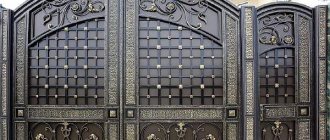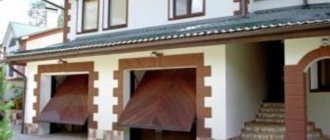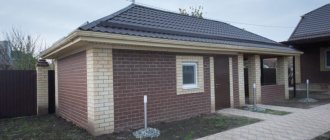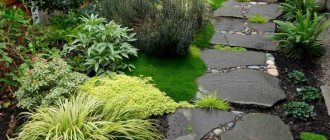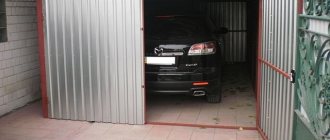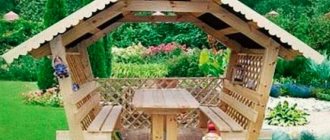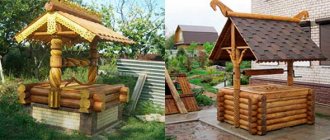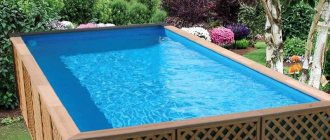Corrugated sheeting is a truly universal building material. It is used for roofing and cladding external walls of private houses. But this does not end the list of its possible applications.
Fences, gates and gates that use corrugated sheets as cladding are very popular. This material has good performance qualities, and the variety of textures and colors will allow you to choose the appropriate option for installing gates made of corrugated sheets.
Features of the correct calculation of gates made of corrugated sheets
The gate or gate in the fence also plays the role of a leading violin. The gate is mainly intended for the passage of people, and through the gate both people and cars are allowed to pass through at the same time.
In addition, a beautiful gate will easily decorate the entire appearance of your home. The most modern and popular are gates and fences made of corrugated sheets, as in the photos presented.
Exclusive option
If the owners want their gates to be special and unique, and also to attract with their aesthetic appearance, then you can opt for forged structures. However, such products are not cheap, which should also be taken into account when purchasing.
Using forging, you can decorate metal structures with all sorts of patterns and designs, through which the surrounding area will be visible. Also, if necessary, you can make tight forging, through which nothing will be visible.
It is important not to lose sight of the fact that the house located behind the wrought-iron gates must match in style and dimensions. The wrought-iron gate looks ridiculous, behind which there is a squat house with a small adjoining area. The advantages of this type of design include:
- Unique design.
- Creation of patterns of any complexity.
- Long service life.
- Good compatibility with other materials.
True, we should not forget about some disadvantages, such as the high price of products and the need to adhere to production technology.
A clearly thought-out design and the use of quality materials will guarantee the beauty and durability of the structure. Such a product will delight owners, guests and passers-by with its attractive appearance for many years.
Advantages of corrugated sheets
Corrugated sheet or profiled sheet is a composite material with a heterogeneous structure. Externally, it is a galvanized steel sheet coated with polymer.
The main feature of profiled products is their protective polymer layers, varying in quantity. A sheet of metal, galvanized on both sides, is one of the simplest, three-layer models.
If galvanized with 10 layers, the products are considered to be of the highest quality. And the service life of the profiled sheet directly depends on the type and quality of the coating. To make a gate from corrugated sheets with your own hands, first of all, you need to find out what material you will have to deal with.
Based on service life, there are three main types of sheet coating:
- galvanized (service life up to 5 years);
- aluminum-galvanized (service life up to 10 years);
- polymer (from 10 to 20 years of service).
By type, profiled sheets are divided into:
- wall (with small waves of profiles: 8, 10, 15, 20, 21 mm);
- roofing (with medium waves: 20, 21, 35, 45, 57, 60, 75, 80, 90, 100 mm);
- carriers (with wave heights of 75, 80, 90, 100 mm).
The most popular are wall profile sheets.
Right choice
Metal profile sizes used for fencing cladding
Corrugated sheets usually differ in thickness, height of steel ribs and strength. There are types of profile steel sheets intended for wall cladding, which have a fairly small thickness and a relatively small rib size. It is this wall corrugated sheeting that should be used for cladding gates with your own hands, since it is a reliable and durable option.
However, it is permissible to use thicker sheets of corrugated sheets, as well as sheets with a high wave. This choice will significantly increase the safety factor of the material, but will also affect the weight, respectively. Such heavy and massive sheets are rarely used for gate cladding, since it is impractical. They are most often used in the construction of garages and hangars, as well as when covering the roofs of buildings.
To get a neat cut and sheets adjusted exactly to the required dimensions, it is better to immediately specify the dimensions when ordering from the factory. This will simplify the work when installing the material on the gate, ensuring beauty and correct dimensions.
Types of gate designs
When choosing gate designs, it is necessary to take into account the ease of their operation, the reliability of protection, and the optimal dimensions for the passage of trucks and cars.
There are two types of gate designs: swing gates made of corrugated sheets, single-leaf or double-leaf, single-sided or double-sided, with or without a wicket) and sliding gates (suspended, rail, cantilever and telescopic).
Briefly about the main thing
Forged gates are evidence of the artistic taste of the owners and the impeccably elegant appearance of the entrance area. The combination of forging and corrugated sheet allows you to save your budget while maintaining an attractive appearance and performance characteristics.
Forged elements increase the strength and reliability of the structure. They can be produced by cold or hot forging. The decor is prepared separately, welded into a composition, painted, covered with patina, and mounted on a frame or canvas. The cost of the finished product depends on the dimensions and design features of the gate, as well as the complexity of the forged patterns.
Ratings 0
Making gates from corrugated sheets with your own hands (step by step)
Making swing gates is difficult, but possible. Even if you are a master with a capital letter, you cannot cope with this matter alone. An assistant with experience in gate manufacturing is simply necessary, because you have to overcome several stages:
- determine the location of the gate;
- make a drawing;
- calculate the need for necessary materials
- prepare the base;
- install racks;
- build a frame and fix it on supports;
- perform sheathing with corrugated sheets.
Gate location and dimensions
First, you need to decide what kind of gate you want: garage or front. Then select their height based on the height of the fence of the site. Ideal option: the gate and fence are at the same level in height from 2 to 2.5 m.
When installing a gate, set the passage width from 1.00 to 1.2 m. When choosing the width of the gate, you should focus on the following factors: proximity to the roadway, turning angle upon entry, fire hazard. The optimal width is 4.00 m.
Required tools and materials
When installing gates from corrugated sheets, you will need ordinary construction tools that you probably still have after building your house: shovels, crowbars, a concrete mixer, buckets, an old basin, a drill, self-tapping screws, etc.
The materials you will need are: paint, sand, cement, crushed stone, locking devices for gates, hinges of sufficient power, pipes of different diameters for the frame and support posts, corrugated sheets.
We adjust the sashes to the racks
First step. We install the gate leaves on stands, which can be made of timber, brick or other suitable material.
Second step. Align the sash along all planes.
Third step. Our frame already has hinge elements. We mark the places for installing the second part of the connecting element on the supports. We weld the hinges to the posts according to the marks.
Fourth step. We hang the sash. We remove the stands installed at the beginning of work.
We place a board at the level of the gate fastening. Level it up
We set the gate according to the level. We tie them to the posts with ropes
Trying on the gate before installation
We cleaned the places for welding hinges from paint on the poles and on the gates
A board was placed in the middle of the gate to raise the gate a little. When we weld them, they will lower a little under their own weight and take a horizontal position.
We connect the gate from above with a pipe and tie it to the posts
We mount the frame of the second rack in the same way. To make the structure even more rigid, we can weld the two outer gate supports with the posts of our fence.
To increase the stability of the gate to wind loads, we can weld a horizontal strip of metal profile along the upper ends of the support posts. This is only relevant for situations where only passenger vehicles will pass through the gate.
We weld one part of the hinge to the stand, the second to the frame, and make cutouts in the corrugated sheet before fastening.
Loops
Don’t get confused, hinges without a pin are welded onto the folding frame
During welding, you need to ensure that the hinges are flush with the profile
Installing hinges
Loops
Next you need to clean the welds with a grinder and a grinding disc and paint the sash with anti-rust enamel
The hinges must be welded parallel to the pole
First, we grab the hinges and then try to open and close the gate. If the gate opens normally, we finally weld the hinges to the posts and to the gate
Finally, all we have to do is paint the parts of the frame that will remain visible after attaching the profiled sheets. We select the paint color so that it harmonizes well with the color of the corrugated sheet and the fence.
Gate frames successfully welded
Painting the frames
Corners were welded over the top hinge of each gate so that the gate could not be removed
Gate installation process (do it yourself)
In more detail, the process of installing gates from corrugated sheets is as follows:
We begin installation of supports by preparing the area (clearing and marking). We outline the location for installing the racks. We fix the level with a thread and proceed to the main work.
We make a depth of 1.5 meters. We fill the bottom with crushed stone and tamp it; if necessary, add crushed stone and tamp again. Then we insert the pre-prepared support (primed and painted) into the recess, secure it with bricks and cobblestones, and fill it with concrete mixture (the ratio of cement, sand, crushed stone is 1:3:6, respectively). To ensure that the mixture sets well, let it dry for about 7 days, periodically sprinkling it with water to avoid cracks.
Before starting this stage, it is necessary to measure the width of the wicket and gate again to avoid discrepancies in dimensions or making necessary adjustments. Next, using a grinder, we cut blanks of a certain size from the profile pipe (angle). We clean their surfaces.
On a flat plane, using welding, we connect the workpieces in the shape of a frame. We check the evenness of the structure (this is important!). If the geometry is correct, we proceed to welding the seams. We strengthen the frame with stiffening ribs.
We fix the sashes to the hinges of the supports. The number of hinges is determined depending on the severity of the sashes. We install the doors on the support between the posts and secure the top with a rope. We mark the location of the hinges and lightly weld them to the sashes and supports. We check the functionality of the valves. If no comments are found, we finally weld the hinges.
After fixing the gate, we proceed to installing fittings (handles, bolts, latches) using welding. We install locking devices, automation, alarms and video surveillance systems.
To paint the frame, you need to prepare its base (clean the metal surface and seams with sandpaper, degrease, prime) so that the paint adheres well to the metal. Then paint with a roller and let dry for about 12 hours.
Lastly, the structure is sheathed with corrugated sheets on top of the frame. We cut off the excess and check the level for evenness. We secure the corrugated sheets carefully with self-tapping screws. The gate is ready.
But, if you doubt your abilities, and you are not embarrassed by the price of gates made of corrugated sheets with installation offered by specialized organizations, then feel free to contact the professionals.
Making a frame
It is advisable to make the frame from the same material as the supports. Most often, the racks and frame are made of metal products. We assemble the frame from profiled pipe.
To assemble the frame, we find a horizontal platform that can freely accommodate at least one sash.
The process is extremely simple: we need to weld a rectangular frame from a pipe (profile) pre-cut into pieces of the required size. The angles must be strictly straight. We verify this using a square.
Marking and welding frame corners
Marking and welding frame corners
Marking and welding frame corners
Having welded the frame, we strengthen it in the corners using steel angles. To give the frame additional rigidity, we divide it in height into 3 approximately equal parts and weld parallel horizontal jumpers along the marks. We also strengthen the junction points of the lintels with the frame using steel corners. We weld the gate hinges at the same points.
When the frame is ready, we weld a steel strip around the perimeter to secure the corrugated sheet.
Helpful advice! There is another popular option for strengthening the frame. To do this, a horizontal jumper is welded in the center of the frame to its vertical sides, dividing the frame into 2 identical rectangles. After this, the corners of each of these rectangles are connected by diagonal jumpers. Choose any of the two hardening methods discussed, they are both good.
The frame for the gate is assembled in a similar way. If you want to make a gate directly in the gate leaf, assemble the frame in a slightly different order. To do this, weld transverse and longitudinal metal jumpers to the rectangular frame of the selected sash, thereby forming the frame of the gate. The average dimensions of the gate are 80x180 cm. If possible, stick to these values. We shift the places where the hinges are attached to the sash to the upper and lower edges of the frame.
Frame for gate
Wicket frame
Prices for popular models of welding machines
Welders
